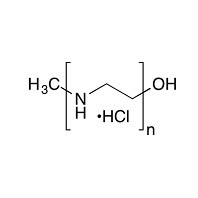
PEI是历史上继多聚赖氨酸之后发现的*种聚合物转染试剂。PEI能将DNA缩合成带正电荷的微粒,这些微粒可以黏合到带有负电荷的细胞表面残基,并通过胞吞作用进入细胞。一旦进入细胞,胺的质子化导致反离子大量涌入以及渗透势降低。上述变化导致的渗透膨胀使囊泡释放聚合物与DNA形成的复合物(polyplex)进入细胞质。复合物拆解后,DNA就能自由的融合到细胞核中。聚Ethylene亚胺(Polyethylenimine,PEI)是一种具有较高的阳离子电荷密度的有机大分子,每相隔二个碳个原子,即每第三个原子都是质子化的氨基氮原子,使得聚合物网络在任何pH下都能充当有效的质子海绵(proton sponge)体。
|
货号 |
产品名称 |
品牌 |
规格 |
备货情况 |
|
23966-1 |
Polyethylenimine, Linear(MW25,000) |
polysciences |
1G |
现货 |
|
24765-1 |
Polyethylenimine Max (Mw 40,000) |
polysciences |
1G |
现货 |
转染试剂线性PEI MAX溶液的配制
线性聚乙烯亚胺盐酸盐(Linear Polyethylenimine Hydrochloride)是线性化聚乙烯亚胺PEI 25,000的升级产品,是一种功能更为强大的高效瞬时转染试剂。与PEI 25000的区别在于:1)完全水解(去乙酰化)2)PEI 25000的盐酸盐形式,具更高的水溶特性 3)含更长连续性乙烯亚胺片段,其质子化氮水平比PEI25000提高11%以上。
另PEI MAX 40K比PEI 25K更易于使用,并且更高效。PEI 25K转染溶液通常需要几个小时才能制备,而PEI MAX 40K可以在两个小时内转化为即用型溶液。而且PEI 25K含有4-11%的残余丙酰基,可防止聚合物主链与DNA强烈结合。PEI MAX 40K完全去乙酰化的结构意味着每批产品的表现始终如一。
下面将主要介绍polysciences 线性PEI MAX(#24765)的产品特性及其溶液的配制过程。
1.产品特性:
产品名称:转染级线性聚乙烯亚胺盐酸盐(PEI MAX)(Linear Polyethylenimine Hydrochloride)
|
CAS号 |
49553-93-7 |
分子式 |
(C2H5N)n ● xHCl |
分子量 |
40000 |
|
外观 |
白色或灰白色自由流动固体 |
储存 |
室温 |
结构式 |
|
|
溶解性 |
溶于低温和室温水;不溶于常用有机溶剂(yichun,丙T,4氢呋喃) |
||||
2.溶液配制
此指导说明书是经polysciences公司研究,测试及其客户反馈的后编写的。下面推荐一种简单适用而高效的方法,讲述*配制浓度为1mg/mL的转染试剂的配制。
材料:
1g #24765、1L 纯水(Milli-Q®纯水,注射用水(WFI),或类似的生物级水)、1N OH化钠、25mL无菌塑料吸管、一次性0.1μm, 0.2μm, 0.22μm PES真空无菌过滤器、无菌高聚乙烯或聚丙烯试剂瓶。
器材:
1 L 玻璃烧杯、1 L玻璃量筒、pH计、移液器、磁力搅拌棒、带油管的真空泵
配制过程:
1g #24765——900mL水溶解——搅拌、加热(60-80°C)——加1N NaOH调pH到6.9-7.1——移液到量筒,加水补足至1L——真空过滤消毒——分装,4°C保存。
备注:加热或加酸都有助于PEI溶解。#24765比#23966易溶,可适当少量加酸,详细用量可试加一点搅拌看看,足够溶解就行,不一定需要加到pH那么低。
聚乙烯亚胺(PEIs)polysciences代理商现货

View pricing for: Americas/Asia, Europe, Taiwan
DESCRIPTIONAdd to CartBulk Quote
PEI MAX 40K (also known as PEI 22K in free base) is a powerful, trusted, and cost-effective transient transfection reagent. In HEK293 and CHO expression systems, PEI offers consistently high gene expression on a wide scale (96 well plates up to 100 L bioreactors). Each year, more researchers and companies turn to Polysciences PEI to gain an edge in their critical work. Relative to most other options, using PEI to prepare transfection reagents in-house can offer as much as a 40% reduction in total transfection costs.
PEI MAX 40K is easier to use and offers consistently higher titers than PEI 25K. PEI 25K transfection solutions typically take several hours to prepare, while PEI MAX 40K can be converted to a ready-to-use solution in under two hours. Additionally, PEI 25K contains 4-11% residual propionyl groups, which prevents the polymer backbone from strongly binding to DNA. PEI MAX 40K’s fully depropionylated structure means each batch performs consistently higher.
Comparison of PEI 25K (#23966) and PEI MAX 40K (#24765).
Method: 10e6/mL HEK293 cells in 50 mL FS transfected with IgG64 plasmid pair. PEI:DNA 4:1. Samples taken 120 hpt. Quantified with Thermo Fisher #23310. N=4 each. Error bar = standard deviation.
A pre-made sterile-filtered solution of PEI MAX 40K is available as our Transporter 5™ Transfection Reagent.
CAS#:
49553-93-7
Molecular Weight:
40,000 (~22,000 free base)
Soluble In:
Cold and room temperature water
Insoluble in: Common organic solvents (ethanol, acetone, tetrahydrofuran)
Appearance:
White to off-white free flowing solid
Reference(s):
Baranyi, L. et al. Rapid Generation of Stable Cell Lines Expressing High Levels of Erythropoietin, Factor VIII, and an Antihuman CD20 Antibody Using Lentiviral Vectors. Human Gene Therapy Methods 24, 214–227 (2013). doi:10.1089/hgtb.2013.002
Delafosse, L., Xu, P. & Durocher, Y. Comparative study of polyethylenimines for transient gene expression in mammalian HEK293 and CHO cells. Journal of Biotechnology 227, 103–111 (2016). doi:10.1016/j.jbiotec.2016.04.028
** Gutiérrez-Granados, S., Cervera, L., Segura, M. de las M., W?lfel, J. & Gòdia, F. Optimized production of HIV-1 virus-like particles by transient transfection in CAP-T cells. Applied Microbiology and Biotechnology 100, 3935–3947 (2016). doi:10.1007/s00253-015-7213-x
Kobayashi, S., Yoshii, K., Hirano, M., Muto, M. & Kariwa, H. A novel reverse genetics system for production of infectious West Nile virus using homologous recombination in mammalian cells. Journal of Virological Methods 240, 14–20 (2017). doi:10.1016/j.jviromet.2016.11.006
** Longo, P. a, Kavran, J. M., Kim, M. & Leahy, D. J. Transient Mammalian Cell Transfection wtih Polyethylenimine (PEI). Methods Enzymology 529, 227–240 (2013). doi:10.1016/B978-0-12-418687-3.00018-5.
Mann JF, McKay PF, Arokiasamy S, Patel RK, Klein K, Shattock RJ. (2013). Pulmonary delivery of DNA vaccine constructs using deacylated PEI elicits immune responses and protects against viral challenge infection. J Control Release. 170(3):452-9.
** Stuible, M. et al. Optimization of a high-cell-density polyethylenimine transfection method for rapid protein production in CHO-EBNA1 cells. Journal of Biotechnology 281, 39–47 (2018). doi:10.1016/j.jbiotec.2018.06.307
Thomas M, Lu JJ, Ge Q, Zhang C, Chen J, Klibanov AM. (2005). Full deacylation of polyethylenimine dramatically boosts its gene delivery efficiency and specificity to mouse lung. Proc Natl Acad Sci U S A. 102(16):5679-84.
** Contains particularly useful information.
TSCA
Hazards:
Irritant
Handling:
Glove, chemical goggles & fume hood
Storage:
Store at room temperature